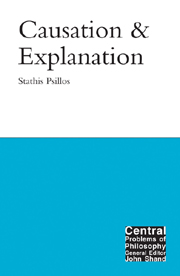9 - Statistical explanation
from III - Explanation
Summary
Hempel's pioneering work on explanation consists really in his analysis of the circumstances under which we can explain events whose occurrence is not certain (cf. 1965: 376–412). Hempel's models of statistical explanation were really the first systematic treatment of the subject. In this chapter, we shall examine these models, and a major alternative to them. Our focus, in the end, will be the implication of statistical explanation for the Humean approach to causation. For there is a firm thought that there are causal relations between event-types that are not linked by strict (deterministic) laws. For instance, we do believe that smoking causes lung cancer, even if there is no strict law that says that whoever smokes develops lung cancer. Lots of delicate issues need to be dealt with here but, in line with the apology offered in the Introduction, I will leave most of them untouched.
Explaining statistical regularities
Suppose that we want to explain a statistical regularity; namely, the fact that in a large collection of atoms of the radioactive isotope of Carbon-14 (C14) approximately three-quarters of them will very probably decay within 11,460 years. This, Hempel (1965: 380–81) observed, can be explained deductively in the sense that its description can be the conclusion of a valid deductive argument, whose premises include a statistical nomological statement. The general claim above follows deductively from the statement that every C14 atom has a probability of 0.5 of disintegrating within any period of 5,730 years (provided that it is not exposed to external radiation).
- Type
- Chapter
- Information
- Causation and Explanation , pp. 241 - 262Publisher: Acumen PublishingPrint publication year: 2002

